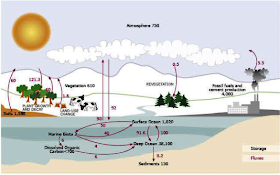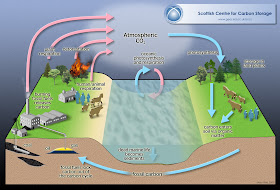Hello :) So here are the things I understood from the notes. The post would be quite lengthy, have a lot of arrows, and notes in point form. So please bear with me.
Carbon is essential as it provides energy through photosynthesis and respiration. The very presence/absence of it helps determine whether a molecule is considered organic or inorganic, and it controls the pH level in the ocean. Also, it allows carbon to be recycled and reused in the biosphere as well as in organisms, and ensures survival. As of today, the pH level of the ocean is decreasing due to the excessive uptake of carbon dioxide in the atmosphere. Carbon dioxide also increases the atmosphere's ability of hold heat, hence the name "greenhouse gas".
Carbon can be found in: carbon dioxide, limestone, diamonds, graphite, the ocean floor, the Earth's mantle etc.
The carbon cycle is a biogeochemical cycle by which carbon is exchanged, in different forms, on Earth. The cycle is divided into two subcomponents: the geological component (of which the elapsed time scale is millions of years) and the biological component (time scale spanning a few days to thousands of years). Carbon movement and exchange occur due to specific chemical, physical, geological and biological processes. Unless there are external influences (e.g. black smoker and uncontrolled deep water oil leak, both of which emit large amounts of sulfite and hydrocarbon (diff. forms of carbon compounds), respectively) that significantly increases/depletes the amount of carbon in the ocean, the cycle occurs gradually.
Difference between carbon sink and carbon source: carbon sink---more carbon enters than leaves (think 'whirlpool' and the carbons sinking); carbon source---more carbon leaves than enters (think 'origin'). Oceans are long-term sinks atmospheric carbon dioxide due to both the ability to form limestone and fossil fuels.
Linking carbon cycle to the rock cycle. (Lots of arrows here).
Forms of interaction: weathering and dissolution, precipitation of minerals, burial and subduction, volcanism
(In the atmosphere)carbonic acid reacts with carbon dioxide and water --> rain --> weakly acidic water reacts with minerals at the Earth's surface --> (chemical weathering) minerals will dissolve into their component ions --> ions will be carried in surface waters (e.g. lakes) and eventually reach the ocean, where they precipitate out as minerals like calcite (CaCO3) --> minerals sink to the bottom of the ocean
-->deposition (meaning 'removal') and burial of calcite --> (over time) limestone will be formed due to compression of sediments --> (geographical condition) subduction --> limestone and seafloor carbon heats up and melts --> carbon rises back up to oceanic surface --> interaction of molecules on oceanic surface
--> carbon dioxide released into the atmosphere
Note: Volcanic eruptions, seeps (places where liquid from the ground oozes out from the Earth surface), vents (openings at the Earth's surface where volcanic material is emitted), and carbon dioxide-rich hot springs, also release carbon dioxide into the atmosphere.
Note: Carbonic acid gas is produced by respiration, burning charcoal/other carbon compounds, when chalk/marble/limestone meets a stronger acid like sulfuric/muriatic acid, etc.
Linking carbon cycle to the hydrosphere.
1. Extreme storms (e.g. hurricanes and typhoons) --> sediments will be washed away into the oceans --> carbon/calcite minerals will be buried under ocean bed --> deposition and burial of carbon/calcite --> limestone formed --> (refer to the cycle written in the section before )
2. (Convection Current concept needed) Oceanic upwell (meaning warm oceanic water rises, cold water sinks) --> cold water on oceanic surface allows carbon from heated limestone (from subduction) and and ocean floor to be released into the atmosphere
Oceanic downwell (inverse of oceanic upwell) --> carbon dioxide from the atmosphere will be converted to dissolved carbon in oceanic water. Atmospheric carbon --> dissolved carbon dioxide.
3. Dissolved carbon dioxide reacts with water to form carbonic acid
Carbonic acid will be in equilibrium (meaning 'reversible') with hydrogen ions + bicarbonate ions when the acid reacts with weathered rocks
Bicarbonate ions will be in equilibrium with hydrogen ions + carbonate ions
Carbonate ions + calcium carbonate (from shells of oceanic microorganisms like phytoplankton) will form carbonate sediments (which form limestone)
4. (Only under certain geological conditions) Organic matter buried --> (over time) deposits of carbon-containing fuels coal and oil formed (remember black smoker and uncontrolled deep-water oil well leak?). Non-calcium containing organic matter is transformed into fossil fuel.
Note: Calcium carbonate is an inorganic carbon.
Linking photosynthesis, respiration, the climate and the carbon cycle.
I'm sure you all know how carbon dioxide plays a role in both photosynthesis and respiration so I won't say much about it. :)
(During daytime) Leaves absorb sunlight --> carbon dioxide taken from the atmosphere; microorganisms consume organic carbon matter (e.g. carbohydrates) --> carbon dioxide returned to the atmosphere through respiration. Level of carbon dioxide and oxygen somewhat the same, not including external factors like extensive burning of fossil fuels, deforestation etc.
(At night) Photosynthesis stops (no solar energy); respiration continues. Atmospheric concentration of carbon dioxide is higher than oxygen's.
(During winter) Plants lose their leaves --> photosynthesis ceases --> atmospheric carbon dioxide concentration increases.
(During spring) Photosynthesis resumes --> atmospheric carbon dioxide concentration reduces.
According to data collected, the Earth's climate has oscillated between relatively warm (interglacial periods) and relatively cold (glacial periods) periods over the past 20 million years.
(Interglacial period) Atmospheric carbon dioxide concentration is relatively high. This period is where we are now, and human activities are increasing carbon dioxide concentrations higher than what have been recorded in the past interglacial periods.
(Glacial period) Atmospheric carbon dioxide concentration is relatively low.
How carbon is emitted/retained but not removed on time (due to artificial causes), consequences of excessive carbon, and solutions carried out by governments:
Sources of carbon:
1. Burning of fossil fuels. Carbon is released into the atmosphere far more rapidly than it is being removed.
2. Deforestation. The ability of photosynthesis to remove carbon dioxide from the atmosphere results in a net increase in atmospheric carbon dioxide level.
Consequences:
1. Rise in average sea-level due to global warming, which melts ice caps. Low-lying coastal cities or cities located by tidal rivers will be exposed, maybe submerged, even.
2. Glacial retreat and species range shifts. Trees may not be able to cope with the extent of global warming.
3. Plant growth will be affected, as some plants/shrubs respond more favorably under high level of carbon dioxide concentration. Grasslands may be invaded by carbon dioxide-responsive grass species.
4. Rise in average global temperature of approximately 1-5 degree celsius in the next half-century.
5. Major changes in precipitation patterns and land use throughout the world.
6. Change in the growth cycle of phytoplankton due to difference in atmospheric carbon dioxide concentration.
Solutions formed:
1. Intergovernmental Panel of Climate Change (IPCC) has been set up to produce reports on climate change.
2. Kyoto Protocol has been carried out to avert the negative impacts linked with human-induced climate change.
To sum up: carbon is released through:
1. Respiration
2. Decay of animal and plant matter
3. Combustion of organic material, which produces carbon dioxide
4. Production of cement (heating of limestone)
5. Volcanic eruptions, seeps, vents, carbon dioxide-rich springs
Okay this is all. Hope you have a greater understanding of the cycle!
Done by: Sylvia :)






